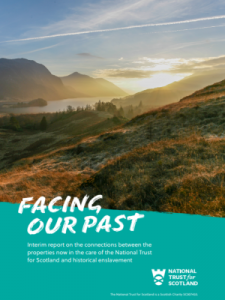 National Trust for Scotland have been working on a new project – ‘Facing Our Past’ – to research the legacies of slavery in Scotland as part of the wider, extensive research undertaken into topics and issues of interest and concern to the Trust.
National Trust for Scotland have been working on a new project – ‘Facing Our Past’ – to research the legacies of slavery in Scotland as part of the wider, extensive research undertaken into topics and issues of interest and concern to the Trust.
…[we] are continuing a review of our buildings and estates in order to highlight the links to slavery…
National Trust for Scotland writes:
For many years, the Trust has uncovered and shared the stories of the people behind our properties. Researching this is important work for us to undertake, in order to better look after, understand and explain the heritage in our care.
In recent years, we have been working on a new project – Facing Our Past – to research the legacies of slavery in Scotland as part of the wider, extensive research we undertake into topics and issues of interest and concern to the Trust.
While our work is at an interim stage and there is more we need to investigate, we now know that many National Trust for Scotland properties have a link to slavery. These links are part of the wider history of Scotland, and we’re committed to expanding knowledge and supporting our staff and volunteers to address Scotland’s role in enslavement where this is associated with our places. With our very large and varied portfolio – featuring museums, grand historic houses, humble cottages, magnificent gardens and landed estates – we have a unique opportunity to realise this ambition across Scotland, using our research to expand on the stories that our properties should tell, helping people to understand better our country’s complex history.
These stories are as much a part of the heritage we are responsible for – and have a duty to explain – as our duty of care to the physical heritage we are entrusted with.
We are continuing a review of our buildings and estates in order to highlight the links to slavery to the millions of people who visit our places each year – we aim to integrate our findings with the historical interpretation. Some of these links include the story about the enslaved young boy (who was later freed) at Culzean Castle in Ayrshire; exploring multi-generational links to West Indian plantations at Pollok House in Glasgow; and looking at how wealth accrued from Jamaican plantations contributed to the building of Glenfinnan Monument.
The Facing Our Past research and public engagement project is addressing these narratives alongside many more, as Project Leader Jennifer Melville explains: ‘Heritage organisations and curators across the world are very aware that they must look honestly at collections, properties and estates and reveal all the narratives relating to them. It is over ten years since our first project on slavery but we are keen to increase this work and embed a thoroughly researched understanding of it into the visitor experience.’
“We know that audiences have a thirst for knowledge, which is based in truth and thorough research. Slavery is part of our shared past, and our audiences are demanding to know more about this.”
Dr Jennifer Melville
Project Leader for Facing Our Past
The interim report below comprises our findings so far from the research of expert Trust members of staff and volunteers associated with our properties, as well as contributions resulting from close partnership working with many individuals and organisations, both in Scotland and internationally. Professor Murray Pittock (Pro Vice-Principal of the University of Glasgow and a member of the Board of Trustees of the National Trust for Scotland) says: ‘Facing Our Past is a key initiative in acknowledging the lost and excluded voices of our history, and in enabling our visitors to see the role of individual people and places in opposing, supporting or simply benefitting from the outrage of chattel slavery.’
Michael Terwey, Head of Heritage & Consultancy Services at the National Trust for Scotland says: ‘The Trust has for many years been uncovering the stories of people behind our properties, increasing knowledge of how they came into existence and their relationship with communities, the land and with wider society. It is an indisputable fact that many of the properties belonging to the Trust have an association with slavery; researching this, alongside the wider historical events, people and circumstances linked to our properties, is therefore important work for us to undertake, as part and parcel of the broader research we do in many fields.’
When the Facing Our Past project began in September 2020, we were aware of around 20 Trust properties across Scotland that had connections to slavery. That number has now doubled to over 40 – more than half of our visited properties – and we anticipate that it may well grow as we continue to carry out further archival research. The report is a summary of the Trust places that we have researched to date.

